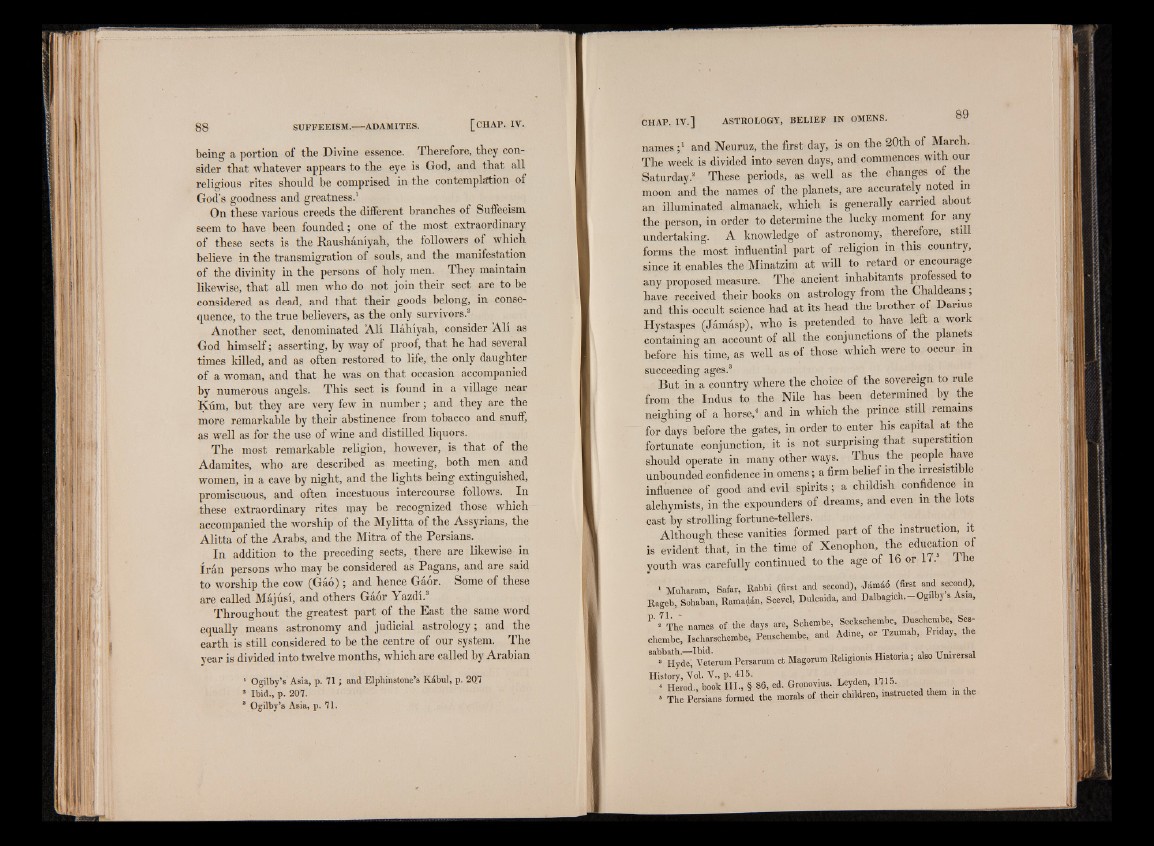
being a portion of the Divine essence. Therefore, they consider
that whatever appears to the eye is God, and that all
religious rites should be comprised in the contemplation of
God’s goodness and greatness.1
On these various creeds the dilferent branches of Suffeeism
seem to have been founded; one of the most extraordinary
of these sects is the Raushaniyah, the followers of which
believe in the transmigration of souls, and the manifestation
of the divinity in the persons of holy men. They maintain
likewise, that all men who do not join their sect are to be
considered as dead, and that their goods belong, in consequence,
to the true believers, as the only survivors.2
Another sect, denominated All Ilahiyah, consider All as
God himself; asserting, by way of proof, that he had several
times killed, and as often restored to life, the only daughter
of a woman, and that he was on that occasion accompanied
by numerous angels. This sect is found in a village near
Kúm, but they are very few in number; and they are the
more remarkable by their abstinence from tobacco and snuff,
as well as for the use of wine and distilled liquors.
The most remarkable religion, however, is that of the
Adamites, who are described as meeting, both men and
women, in a cave by night, and the lights being extinguished,
promiscuous, and often incestuous intercourse follows. In
these extraordinary rites may be recognized those which
accompanied the worship of the Mylitta of the Assyrians, the
Alitta of the Arabs, and the Mitra of the Persians.
In addition to the preceding sects, there are likewise in
Irán persons who may be considered as Pagans, and are said
to worship the cow (Gáó); and hence Gaor. Some of these
are called Májúsí, and others Gáór Yazdi.3
Throughout the greatest part of the East the same word
equally means astronomy and judicial astrology; and the
earth is still considered to be the centre of our system. The
year is divided into twelve months, which are called by Arabian
1 Ogilby’s Asia, p. 11 ; and Elphinstone’s Kábul, p. 207
* Ibid., p. 207.
* Ogilby’s Asia, p. 71.
names and Neuruz, the first day, is on the 20th of March
The week is divided into seven days, and commences with our
Saturday.2 These periods, as well as the changes of the
moon and the names of the planets, are accurately noted in
an illuminated almanack, which is generally carried about
the person, in order to determine the lucky moment for any
undertaking. A knowledge of astronomy, | therefore, still
forms the most influential part of religion in this country,
since it enables the Minatzim at will to retard or encourage
any proposed measure. The ancient inhabitants professed to
have received their books on astrology from the Chaldeans,
and this occult science had at its head the brother of Darius
Hystaspes (Jàmàsp), who is pretended to have left a work
containing an account of all the conjunctions of the planets
before his time, as well as of those which were to occur in
succeeding ages.3
But in a country where the choice of the sovereign to rule
from the Indus to the Nile has been determined by the
neighing of a horse,4 and in which the prince still remains
for days before the gates, in order to enter his capital at the
fortunate conjunction, it is not surprising that superstition
should operate in many other ways. Thus the people have
unbounded confidence in omens ; a firm belief in the irresistible
influence of good and evil spirits ; a childish confidence in
alchymists, in the expounders of dreams, and even m the lots
cast by strolling fortune-tellers. _ . . .
Although these vanities formed part of the instruction, it
is evident that, in the time of Xenophon, the education of
youth was carefully continued to the age of 16 or 17. 1 e
1 Muharam, Safar, Rabbi (first and second), .Jàmàó (first and second),
Rageb, Sohaban, Ramadàn, Scevel, Dulcaida, and Dalbagich.-Ogilby s Asia,
S f | names of the days are, Schembe, Seckschembe, Duschembe, Ses-
chembe, Ischarschembe, Penschembe, and Adme, or Tzumah, Friday, the
" ^ H y d l i v Ì r u m Persarum et Magorum Religionis Historia; also Universal
History, Vol. V., p. 415.
4 Herod., book III., § 86, ed. Gronovms. Leyden, 1715.
. ___ .1 . 1,0 nf their children, instructed them in the